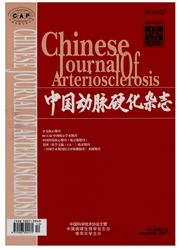

 中文摘要:
中文摘要:
动脉粥样硬化(atherosclerosis,As)是一个多因素参与的复杂疾病,其中血管壁胆固醇蓄积和炎症反应是其发生发展的两个关键环节,而两者又相互促进。三磷酸腺苷结合盒转运体A1(ATP binding cassette transporterA1,ABCA1)是一种膜整合蛋白,通过与载脂蛋白AⅠ(apoAⅠ)结合,促进细胞内胆固醇流出并抑制血管壁炎症反应。人类ABCA1基因突变导致血浆高密度脂蛋白(HDL)水平降低,并增加心血管疾病的风险。ABCA1基因敲除动物不仅表现出低的血浆HDL水平,还表现出胰腺β细胞功能紊乱、体内促炎状态和As斑块的形成。多种促As的炎症因子和代谢产物可能通过下调ABCA1的表达,从而促进As相关心血管疾病的发展。因此,ABCA1有望成为心血管疾病和糖尿病新的治疗靶标和研究方向。
 英文摘要:
英文摘要:
Atherosclerosis(As) is a complex process where both of cholesterol accumulation and inflammation in vessel wall play crucial roles in its development.ATP-binding cassette transporter A1(ABCA1) is an integral cell membrane protein that exports cholesterol from cells and suppresses vascular inflammation via binding of the apolipoprotein AⅠ(apoAⅠ).ABCA1 mutations in human can reduce plasma HDL levels and increase the risk for cardiovascular disease.Genetic knockout of ABCA1 in animal not only affect plasma HDL levels but also impair pancreatic β cell function,inflammation and promoting the progress of atherosclerosis.Inflammatory cytokines and metabolites inhibit ABCA1 protein and decrease cholesterol export from macrophages,raising the possibility that an impaired ABCA1 pathway contributes to the enhanced atherogenesis associated with common inflammatory and metabolic disorders.The ABCA1 has therefore become a promising new therapeutic target for treating atherosclerosis.
 同期刊论文项目
同期刊论文项目
 同项目期刊论文
同项目期刊论文
 Inflammation, lipid metabolism dysfunction, and hypertension: Active research fields in atherosclero
Inflammation, lipid metabolism dysfunction, and hypertension: Active research fields in atherosclero Interleukin-18 and Interleukin-12 Together Downregulate ATP-Binding Cassette Transporter A1 Expressi
Interleukin-18 and Interleukin-12 Together Downregulate ATP-Binding Cassette Transporter A1 Expressi Tristetraprolin-dependent Post-transcriptional Regulation of Inflammatory Cytokine mRNA Expression b
Tristetraprolin-dependent Post-transcriptional Regulation of Inflammatory Cytokine mRNA Expression b PAPP-A negatively regulates ABCA1, ABCG1 and SR-B1 expression by inhibiting LXR alpha through the IG
PAPP-A negatively regulates ABCA1, ABCG1 and SR-B1 expression by inhibiting LXR alpha through the IG Epigallocatechin-3-gallate prevents TNF-alpha-induced NF-kappa B activation thereby upregulating ABC
Epigallocatechin-3-gallate prevents TNF-alpha-induced NF-kappa B activation thereby upregulating ABC AOPPs Inhibits Cholesterol Efflux by Down-regulating ABCA1 Expression in a JAK/STAT Signaling Pathwa
AOPPs Inhibits Cholesterol Efflux by Down-regulating ABCA1 Expression in a JAK/STAT Signaling Pathwa Apolipoprotein A-I inhibits LPS-induced atherosclerosis in ApoE(-/-) mice possibly via activated STA
Apolipoprotein A-I inhibits LPS-induced atherosclerosis in ApoE(-/-) mice possibly via activated STA Tertiary-Butylhydroquinone Upregulates Expression of ATP-Binding Cassette Transporter A1 via Nuclear
Tertiary-Butylhydroquinone Upregulates Expression of ATP-Binding Cassette Transporter A1 via Nuclear The Interaction of ApoA-I and ABCA1 Triggers Signal Transduction Pathways to Mediate Efflux of Cellu
The Interaction of ApoA-I and ABCA1 Triggers Signal Transduction Pathways to Mediate Efflux of Cellu MicroRNA-19b promotes macrophage cholesterol accumulation and aortic atherosclerosis by targeting AT
MicroRNA-19b promotes macrophage cholesterol accumulation and aortic atherosclerosis by targeting AT Growth differentiation factor-15 induces expression of ATP-binding cassette transporter A1 through P
Growth differentiation factor-15 induces expression of ATP-binding cassette transporter A1 through P 期刊信息
期刊信息
